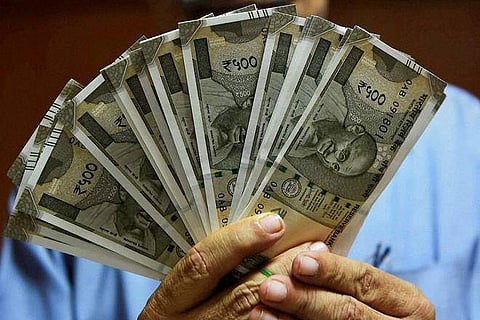

NEW DELHI: A top-up of Rs. 1.5 lakh crore to the Emergency Credit Line Guarantee Scheme (ECLGS), taking the total outlay to Rs. 4.5 lakh crore, has come as a major relief for Covid-hit industries struggling to limp back to normalcy, with demand in both the domestic and export markets have been hit badly.
The move comes as loan sanctions under the scheme near the Rs. 3 lakh-crore mark after the government expanded the scope of the scheme beyond small businesses.
However, the success of ECLGS as well as another Rs. 1.1 lakh crore loan guarantee scheme for contact-intensive sectors will depend on lenders’ willingness to lend. Banks’ anxiety surfaces even as the government stands guarantee for the credit risk.
On the other hand, merely opening a credit facility may not necessarily mean that people would want to take it as these loans could add to the indebtedness of borrowers in a depressed demand situation, say analysts.
The push for cheaper credit may not yield desired results also because the pandemic has forced banks to tighten underwriting policies, rendering many borrowers ineligible for loans under the government’s credit guarantee schemes.
“These guarantee-backed loans have a 12-month moratorium. Few companies are keen, but there is no clarity if these borrowers will be able to repay these loans given the underlying stress in businesses. Others are unwilling to raise debt. Aviation sector, for example, is already reeling under huge debt. Same for the tourism sector as businesses remain halted. More loans could worsen their debt levels. Much depends on the third wave. We don’t know yet. The silver lining, however, is we have been increasing provisions to cover for the losses,” said a senior banker, requesting anonymity.
Anil Gupta, vice-president, financial sector ratings, ICRA, pointed out that if the additional Rs.1.5 lakh crore loan under ECLGS goes to the same borrower who has availed loans under ECLGS 1.0, their leverage would be higher than pre-Covid levels in terms of their absolute quantum of debt.
“In some cases, some borrowers may have repaid the loans but there are questions on how many have overleveraged and if they will be able to repay the loans,” he added.
Out of the original Rs. 3 lakh crore limit, banks have sanctioned a cumulative Rs. 2.69 lakh crore and disbursed around Rs. 2.1 lakh crore under ECLGS, according to the latest available data.
The scheme is now available until September 31, 2021, or till guarantees worth Rs. 4.5 lakh crore are sanctioned, whichever is earlier.
Analysts, however, say the pace of utilisation of ECLGS has been quite slow.
For instance, the exposure of public sector banks has been about 1-1.5 per cent of net advances, while the impact for the frontline private banks is also not high (2 per cent of loans) as on May 31, 2021.
“Our initial thesis was that the borrowers and lenders would look to utilise the scheme in a relatively short time after the window was opened. But, we see banks have been quite restrictive in using ECLGS. It is quite hard to understand if this behavior represents borrowers or lenders lack of confidence to recover from this slowdown or confidence to come back strongly once the economy returns to normalcy,” analysts from Kotak Institutional Equities wrote in a recent note.
Despite the availability of ample liquidity in the banking system and the Centre’s credit-driven stimulus to tame the impact of Covid-19, bank credit growth hit a new low in FY21 at 5.56 per cent — the lowest in 59 years.
In absolute terms, credit offtake stood at Rs 109.51 lakh crore in FY21. Outstanding bank loans fell 0.8 per cent in the first two months of the ongoing fiscal to Rs. 107.5 lakh crore, which translates into a contraction of Rs. 86,000 crore.
According to RBI data, credit growth stood at 5.7 per cent in June 4, lower than 6 per cent in May 21, primarily due to risk-aversion.
While the second wave of Covid-19 pandemic has called for more fiscal measures through increased spending, the government has rolled out measures which excessively rely on bank loans.
Bankers say that the loan disbursements under credit guarantee scheme were towards borrowers who utilised the scheme to lower the cost of debt and not necessarily to improve cash flows.
At this juncture, direct measures through tax cuts or cash transfers would have propped up the collapsed economy but it remains to be done.
“While the measures are welcome and target Covid sensitive sectors, most of the fiscal support is still below the line and in the form of loan guarantees, and not direct stimulus,” said Madhavi Arora, lead economist, Emkay Global Financial Services.
The Centre also announced a Rs. 7,500 crore credit guarantee scheme to facilitate loans to about 25 lakh small borrowers via microfinance institutions.
Under the scheme, a loan amount of up to Rs 1.25 lakh will be provided per individual. Interest rate will be capped at MCLR plus 2% with maximum loan tenure of 3 years.
This, however, is for new lending and not repayment of old loans. Borrowers with pending dues up to 89 days, too, can avail credit.
"There is a need to rebuild confidence amongst the people so that the consumption demand gains traction on a sustained basis," said Sanjiv Mehta, senior vice-president, FICCI, adding, “We are hopeful more measures on these lines from the government are under consideration".